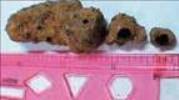
Pieces from Krishna City
Chennai: Krishna’s mythological city of Dwarka may have been destroyed by a tsunami 3,000 years ago, a group of ocean scientists have claimed. The Indian version of the ancient Greek legend of "Lost Atlantis" was offered at a recent seminar here by a team from the National Institute of Ocean Technology (NIOT), Chennai.
Researcher D. Venkata Rao suggested that undersea ruins in the Gulf of Cambay off Gujarat are the debris of a city that suffered a "tectonic upheaval similar to the December 2004 tsunami that submerged the entire landmass".The discovery of the ruins in 1999-2004 by the institute had set off a heated debate whether they were the remnants of Krishna’s Dwarka.The then HRD minister, Murli Manohar Joshi of the BJP, had claimed the ruins were 9,500 years old and would lead to a rewriting of world history, crowning a Hindu India as the cradle of civilisation over the claims of Egypt, Mesopotamia and the Indus valley.

A portion of a mud wall and pieces of pottery
Rao and research partner B. Sasisekaran, however, dated the undersea finds to around 2280 BC, citing tests on a piece of pottery they had sent to Oxford University.They said more evidence was needed to establish whether the finds were indeed the ruins of the city of Dwarka mentioned in the Mahabharat. But there was sufficient evidence, they said, that an ancient city at the site was swallowed up by the sea sometime around 1000 BC.Their paper, presented at the international symposium on "Indus civilisation and Tamil language", cited independent seismic surveys by Manipur University and the Deccan College of Archaeology, Pune.
Both teams had suggested that the region, off Shivali and Hazira on the Gujarat coast, had suffered "major tectonic upheavals" around 3000 BC, 1000 BC and AD 550. Given the period to which the city has been dated, it’s the second of these earthquakes that would have destroyed it, Rao said."We revisited the area and covered (it) by site scan, through underwater high resolution seabed photography and even mapped the sea floor," Rao said.
The NIOT then did its own seismic studies and found that the sea floor bore the signature of several upheavals."The seismic sections depict that the area had undergone intense folding and faulting. The layers are sheared and conspicuously absent with several features of faulting at surface and subsurface," Rao said quoting from the paper. He added that the seismic activity "seems to undergo periodic reactivation, resulting in many neo-tectonic activities affecting the seabed".
The NIOT’s study suggested the tsunami waves unleashed by these earthquakes might have been up to 12 metres tall. From the artefacts the institute recovered from the seabed, it sent a piece of pottery to the Luminescence Dating Laboratory at Oxford University. "It gave a calibrated date of 4,287 years Before Present (around 2,280 BC) for the pottery piece," Rao said.
"The date led us to surmise that this part of the land might have had trade links with some area falling under the Indus valley civilisation." Rao cited another significant find. "A clay seal, a glyptic, without words found at Cambay is identical with glyptics from Mohenjodaro." The seal, a piece of baked clay with an impression, "was found on one of the walls made of wattle and daub recovered through dredge".Rao and Sasisekaran, who were helped by NIOT director S. Kathiroli and numismatics expert S. Srinivasan, theorise that there may have been a migration from the Indus valley to the Gujarat coast.As for the Dwarka theory, they cite how the Mahabharat and the Brihatkatha — believed to have been written in the second century BC — mentions Dwarka being washed undersea.
(This is the proof to those who so called intellectual (?) says Mahabharata was imaginary ! – Editor)
http://www.telegraphindia.com/
Related HJS Campaign
> Save Temples

